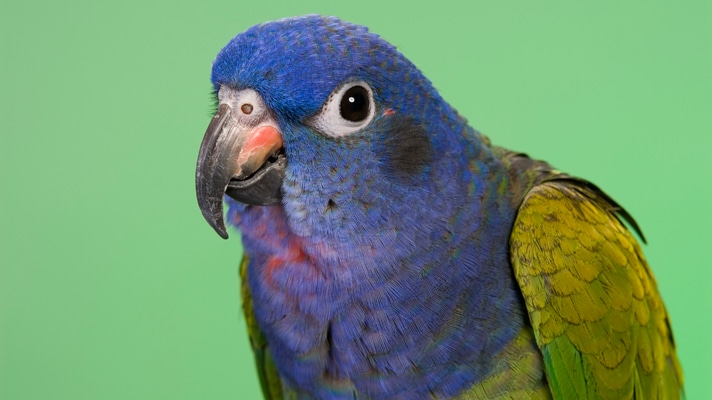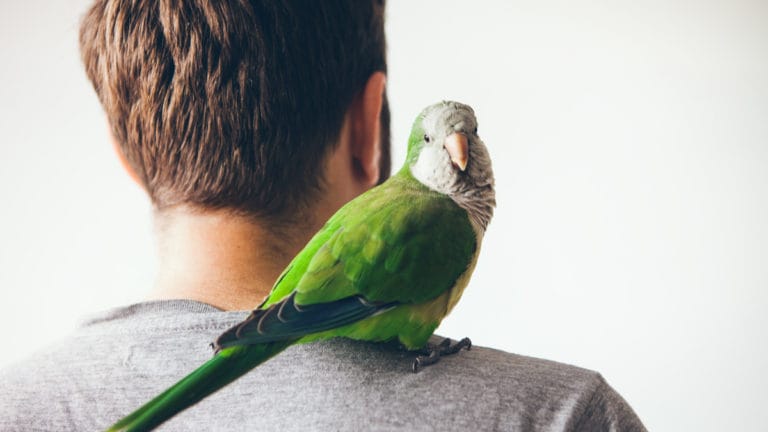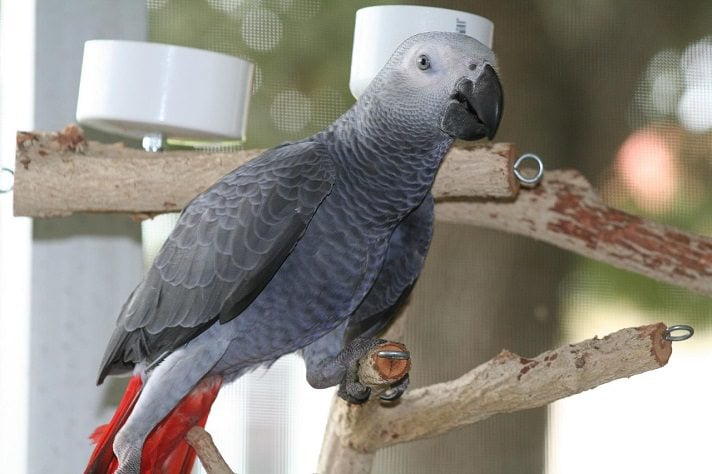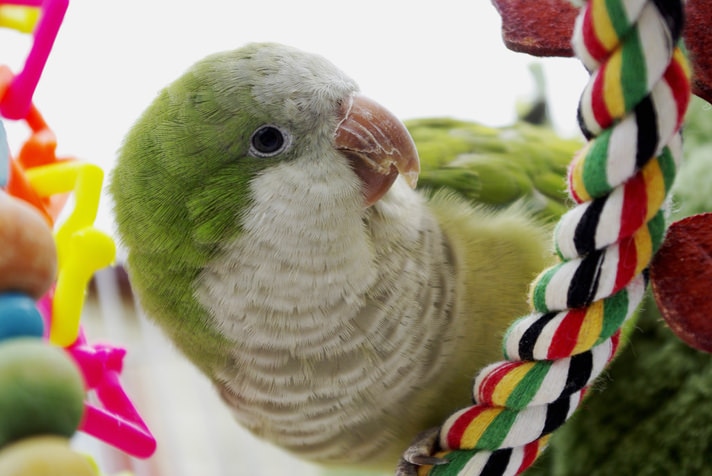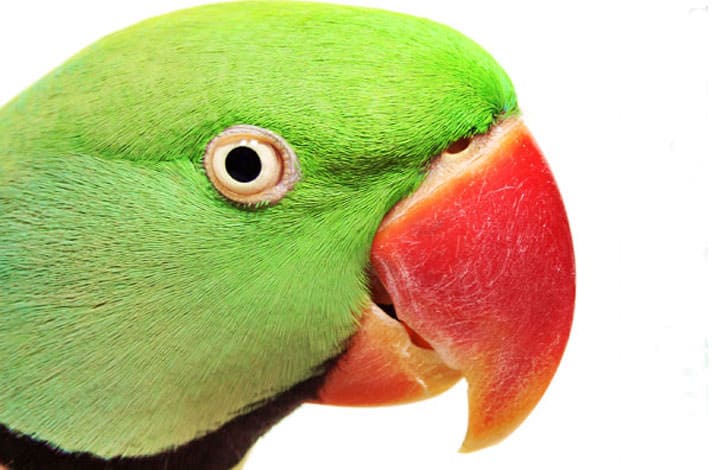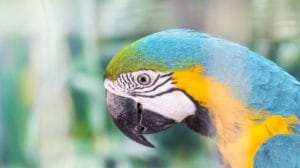If you are looking to get a pet bird or already have one, chances are your favorite aunt or a well-meaning co-worker has filled you in on what a parrot brings to your home. You probably heard all the stories about the “worst parrot ever” and about someone who knew someone who had their eye poked out. Chances are also good that what you have been told is not quite right. So here are a few misconceptions and missed truths that can help you get off on the right foot with your parrot pal.
The 3 Things You Know About Parrots That Might Not Be True
If you’ve heard any warning words at all about parrots it is probably that they bite, scream and make a mess. If you are a parrot lover, you likely figure you can handle these three little things. Maybe you even accept them as the simple truth of sharing your home with a parrot. However, in the wild, parrots don’t “scream,” they rarely bite, and they might not be as messy as they seem. So surprisingly, these three behaviors are not a given in your home.
1. Parrots scream.
Sure parrots can be loud, but most people can tolerate a bit of noise. It is the loud, prolonged repetitious noises that parrots make that drive us nutty and put us in danger of eviction. This is screaming and not something parrots need to do in the wild. A call across the forest usually gets an answer and the parrot is able to fly to its companion. Parrots in the wild do not need to sit in the same place and scream for a half an hour in order to interact with their companions. Screaming is something that people teach parrots to do. Parrots can learn very quickly that when they scream they get our attention. It’s hard to ignore a screaming parrot, but entering the room to tell a pet bird to hush is “answering the call” and giving it the attention it craved. Parrots don’t naturally scream; we teach them to scream. Instead we should teach them a more acceptable noise or activity that gets them our attention.
2. Parrots bite.
Parrots rarely need to bite in the wild. For the most part the threat of a bite keeps parrots out of each other’s personal space. Through a variety of body language, one parrot conveys to another that it is too close or in its territory. Usually, the offending parrot takes these threats seriously and flies off before any blood is shed.
People, on the other hand, miss the body language and don’t back off until they get bitten. Pet birds might quickly learn to skip all the signs of aggression and jump straight to the bite, which is the only thing their caretaker seems to understand. Just like screaming, we teach our pet birds to bite. Instead, respect your parrot’s body language and watch it closely. If you ignore its pinning eyes or some other sign and pick it up anyway, you are teaching your pet bird to bite.
3. Parrots are messy.
Are parrots really messy? Well, that depends on how you define messy. If you had to crack shells, strip bark, hollow out trees and forage through foliage to find your food, you would be pretty good at making a mess in the right environment, too. If you asked your parrot though, it would probably say it was making a living, not making a mess.
Parrots need the opportunity to play and explore with their beaks and feet. If you would prefer your parrot didn’t strip and hollow your furniture, it needs more to play with in its cage and acceptable bird toys that it is encouraged to destroy. Maybe parrots are not quite as messy as we think!
10 Parrot Truths No One Told You
So if it isn’t really true that all parrots are destined to bite, scream and make a mess, what is the truth? What is it that nobody told you about parrots? Here are ten things you may not hear and should know about the parrot in your life.
1. Parrots are species, not breeds.
Parrots are obviously very different from dogs and cats, but maybe even more so than you realize. Dogs are all one species of animal, Canis familiaris. A Labrador retriever looks entirely different from a Chihuahua, but they are the same species, just different breeds. Cats are also one species, Felis catus. Although a Maine coon looks very different from an Abyssinian, they are, again, all the same species but different breeds. Parrots on the other hand come in hundreds of species. Some are even from different genera, which mean an even bigger gap in their relations on the family tree. While we can make blanket generalizations about the nutritional, emotional and physical needs of dogs because they are all one species, the same is not true of parrots.
Macaws from South America are very different from African greys or Australian cockatoos. It isn’t just their colors and body shape either. Their body language may be different. They may eat different foods in the wild and require slightly different nutrition. It isn’t enough to just know something about parrots. Understanding that you need to learn about your pet bird as a species and then as an individual is an important start to great lifelong relationship.
2. Parrots are wild, not domestic.
We have selectively bred cats and dogs for thousands of years, but we have mostly kept our parrots wild. With the exception of maybe budgies and cockatiels, most parrots have not been bred for color, features or temperament. In fact, we can trace the lineage of most parrots back two or three generations from the wild. Where dogs and cats have been domesticated, parrots have simply been tamed. What does this mean? It means a very different kind of pet in your home from your favorite dog or cat.
While domesticating, we chose to breed our pets for characteristics that suited our lifestyle. We like dogs that are easily trained the rules of the household and seem to have a desire to learn them. We like cats that enjoy curling up on our lap for a nap. Humans mainly chose to breed the animals that gave us relationships we really enjoyed. Parrots on the other hand are exactly what they were in the wild. They weren’t bred to be the perfect pet, so your relationship will not be an intuitive as with a domestic animal. For many that is greatest joy of having a parrot in their home, the work it takes to build a relationship. Don’t expect your parrot to look for ways to fit into your home. Instead, you are going to have to work to encourage acceptable behavior and communicate its rewards.
3. Parrots have strange body language.
Humans have lived with dogs and cats for a very long time and most of us are excellent at reading their body language. In fact, they are pretty obvious about their physical communications to us. We are all more likely to walk up to a dog that is wagging his tail. Most of us also know not to try to pet a hissing cat. However, do you know what a parrot looks like when it is about to bite or when he is hoping to get a scratch on his head? If you don’t, you’re not alone.
Feathers and beaks are more difficult to read than fur and fangs, but worth the effort in learning. With some effort you can learn what your parrot looks like when it wants to get away, is concerned about a new object in the room, is hoping to be picked up for a kiss and cuddle or when he just wants to go back to his cage. If you work to learn these subtle signs and then acknowledge them, your parrot won’t have to use more obvious language, like biting and screaming to get what he needs or wants. However, the key is that you have to learn your bird’s body language.
4. Parrots require complicated nutrition.
If you are new to the world of parrots, then you may think that all you have to do is give pet bird’s fresh seed and water. For many years this was what we all thought and were led to believe that this meant feeding our parrots was the easiest part of keeping them. Thoughts on parrot nutrition have changed drastically in the last few decades. After all, most parrots eat a lot more than seed in the wild. They eat a tremendous variety of nuts, fruits, foliage and even grubs. Many parrots even consume small amounts of soil, clay and particular plants that probably have minerals that they need. They need a lot more than seed!
As you begin to research, you will discover that there is a large variety of parrot bird food available and many thoughts on what parrots need for optimal health. Everyone agrees though that parrots need a variety of food, including fresh fruits and vegetables. This will mean more shopping and more preparation time than just pouring seed in a bowl. Parrots also react differently to foods than dogs or cats. Things that are just fine for you or your other pets to eat may be poisonous to your parrot.
5. Parrots have complicated physiology.
It is not as easy or as inexpensive to get veterinary care for your parrots and this is mainly because a parrot’s body is very different from a mammal, like a dog. They have delicate bones, sensitive respiratory systems and entirely different diseases than dogs or cats. These diseases can be complicated to both diagnose and to treat. Illnesses are also not always easy to identify because pet birds rarely show obvious signs of sickness until they are extremely ill.
Veterinarians that specialize in pet birds need to invest a tremendous amount of time in learning about bird physiology and the diseases that affect them. They also have to purchase very expensive equipment to diagnose and treat pet birds that is not as readily available as the equipment normally found in veterinary practices. So in order to cover their costs, avian veterinarians may have to charge more for tests and treatments. You should simply expect to have to spend time looking for an avian veterinarian and to spend more money for checkups and illnesses.
6. Parrots have complicated brains.
Not only do parrots have complicated bodies, but they also have amazing minds. There is a lot going on in that feathered head and for the sake of a parrot’s well-being, you should plan on working to give that pet bird brain something to do. It is never enough to just leave a parrot in a cage with a few toys. They come from interactive environments in the wild and need extremely interactive homes.
Parrots not only need time outside of the cage, but activities to keep them happily occupied. The closer this activity comes to what they would normally do in the wild, the better. Toys and environments that allow parrots to forage are great for keeping their minds and bodies busy. This will mean making the effort to think about designing a play area, buying or making toys and dedicating some of your own time every day to participating in parrot play. If you thought a parrot would be easier than having to walk a dog every day you might be surprised.
Parrots have active minds and thrive in an environment worthy of investigation. In fact, a healthy parrot requires it.
7. Parrot training is a necessity, not a possibility.
When we get a new puppy we often think about signing up for training classes. Most of us know that when our dog doesn’t behave it is because we haven’t trained him. It is not very different for parrots. Actually, it is even more important for parrots. Training is the way you learn to have a two-way conversation with your parrot.
Spending some time teaching your parrot a few tricks or a few important behaviors like stepping up and going into a carrier, gives you the opportunity to pay closer attention to your pet bird’s body language. It also helps your parrot to learn how to learn. Parrots that understand that desirable behavior has rewards like treats or your attention, experiment to find ways to get treats. You become a better communicator, too. A parrot owner who trains her pet bird is more mindful of rewarding behavior she appreciates and careful not to accidentally reward behaviors she does not enjoy. Pretty soon you have a pet bird that is not only a great companion, but a happy parrot that enjoys interacting with its household.
8. Parrots require life-long plans.
Most parrot owners understand that their pet birds will live a long time and are committed to caring for their feathered friend throughout their lifetime. Commitment is the easy part. The harder part is realizing that, just like a human relationship, friendship with a parrot has its up and downs. You cannot be certain what life will bring you next. You might find yourself in a new relationship, living in a new city or having a new work schedule in the next 30 years. Likely, your parrot will be with you for all of this. Have a plan.
Prepare your parrot for change. Teach your parrot important skills, such as getting into a travel carrier to travel comfortably and to tolerate new people. Remember, too, that relationships are always evolving and a parrot that once seemed perfect might begin to exhibit problem behaviors. If you’ve spent time working with your pet bird on basic training, however, you’ll be able to problem-solve and get your relationship back on track. Relationship building with a parrot is a life-long endeavor.
9. Everything we know about parrots will evolve.
This is an exciting time to be involved in aviculture. Scientists learn new things in the laboratory and in the field every year. There is still so much to learn about parrots, and much that we know now was discovered in just the last couple of decades. New information will be coming so keep an open mind and keep up on the science. We are likely to find out new information regarding nutrition, physiology and behavior. So if you thought there was nothing new under the sun, think again!
10. Parrots are just as much fun as they are work.
After reading the first nine truths, you might be thinking that a parrot is a tremendous amount of work. Certainly they can be, but to devoted parrot lovers, all of this effort would never be considered work. A happy, healthy, well-behaved parrot is such a joy that the time spent to give parrots a great life is time that enriches our own lives. It is important that you give your parrot all of the things it needs, but it shouldn’t be such serious business. Having a parrot in your home is tremendous fun. So don’t forget to clown around with your feathered friend, laugh at its antics and enjoy a life gone to the birds!
5 Things You Should Do if You Have a Parrot
- Find an excellent veterinarian, preferably an avian veterinarian.
- Find an avian behavioral consultant.
- Join a parrot club.
- Go to lectures and workshops on parrot training and behavior.
- Read expert advice on trusted websites like Petcha.com.
Common Wisdom
Just because you hear something often does not make it true. In fact, if you have heard something time and time again, there is a good chance it is just common wisdom. You may frequently hear things such as “sexually mature parrots are happier in breeding situations” or “male parrots like men better” or “all cockatoos are cuddly.” None of these things are necessarily true. Just because you have heard several people say something does not mean you should believe it. Do your homework! Ask your veterinarian and do some research.
How Much Time Does a Parrot Take?
Time spent feeding, cleaning, playing and training sounds like a big chunk out of your day. Sure, you should spend as much time with your parrot as you can manage, but there is no formula for being the perfect parrot owner. Do the best you can. A good routine and prepping food in advance can save you a lot of time. And taking 10 minutes twice a day to train your pet bird can go a long way.
Posted by: Chewy Editorial
Featured Image: Robert Hambley/Hemera/ThinkStock
Share:
